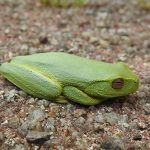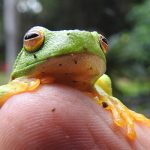DAINTY GREEN TREE FROG
Meet the Dainty Green Tree Frog
Step into a warm, damp evening in eastern Australia. The air smells of wet leaves and earth, and the trees glisten after a light shower. From the reeds by a still pond comes a small, steady chorus—soft notes pulsing like tiny heartbeats. A bright green figure, no longer than your thumb, rests on a leaf beaded with water. Its skin looks freshly polished by rain, its golden eyes alert. This is the Dainty Green Tree Frog, a little ambassador of healthy wetlands.
Quick facts
| Feature | Detail |
|---|---|
| Common name | Dainty Green Tree Frog |
| Scientific name | Ranoidea gracilenta (often still listed as Litoria gracilenta) |
| Size | About 25–40 mm (snout–vent length) |
| Range | Eastern Australia: northern Queensland to northern New South Wales |
| Habitat | Rainforests, wet woodlands, heath, riparian zones, and garden ponds |
| Status | Least Concern (IUCN) |
How to identify them
- Colour: Usually a bright leaf-green, sometimes with a yellowish wash on the sides and underbelly. They can shift to darker green or brown to blend with bark or shaded foliage.
- Markings: Often a fine pale line along the upper lip and towards the shoulder. Thighs may show lemon-yellow tones, especially when they move.
- Skin and shape: Smooth, slender, and delicate—hence “dainty”.
- Eyes: Large golden irises with fine dark reticulations, giving a net-like pattern.
- Toes: Broad, sticky pads for climbing; they move confidently across slick leaves and slender stems.
Tip: They are most active on warm, humid nights after rain, when their colours look especially vivid under torchlight.
Where they live
From the tropics of northern Queensland down into northern New South Wales, these frogs favour warm, moist places. Look for them:
- Along creeks, ponds, dams and swamps with plenty of vegetation
- On the edges of rainforests and in wet sclerophyll forest
- In gardens and urban green spaces, especially near water and dense shrubs
They rely on clean, still or slow-flowing water for breeding, and on leaf-rich vegetation for shelter and foraging.
Diet and daily life
Picture a frog perched quietly on a glossy leaf. It waits, motionless, feeling the faint tremor of an approaching insect through the leaf’s surface, and sensing movement with keen eyes. Then—snap. A quick tongue, a swallowed moth. Their menu includes moths, crickets, flies, beetles and other small invertebrates. By feeding at night and resting in cover by day, they conserve moisture and avoid many predators.
Breeding: the sound of rain
- Season: Mostly spring to autumn, peaking after rain and during warm spells (timing shifts with latitude and rainfall).
- Call: Males give a soft, repeated series of brief notes—often described as gentle “weep-weep” or “reek” pulses—carried from rushes and low branches near the water’s edge.
- Eggs and tadpoles: Females deposit small clusters of eggs attached to submerged plants or leaf litter. Tadpoles graze and grow for several weeks to a few months before metamorphosing into miniature, bright-green juveniles.
With favourable conditions, individuals can live several years; some may reach close to a decade, particularly where predators are few and water stays clean.
Look-alikes and how to tell them apart
- Eastern Sedgefrog (
Litoria fallax): Also small and green, often with a darker stripe through the eye along the flank. Calls are higher-pitched and more “ticking.” - Australian Green Tree Frog (
Litoria caerulea): Much larger and bulkier, with heavier skin folds and a deeper, slower call.
If you are unsure, a clear photo of the side of the head and the thigh colour can help with identification.
Conservation status and gentle reminders
The Dainty Green Tree Frog is listed as Least Concern, and that is good news. Even so, amphibians are sensitive to change, and their challenges are our warning signs:
- Habitat loss and fragmentation reduce breeding sites and shelter.
- Water pollution, pesticides and nutrient runoff harm both adults and tadpoles.
- Disease, especially chytrid fungus (
Batrachochytrium dendrobatidis), affects many frog species. - Climate change shifts rainfall patterns and dries breeding pools.
Small actions help:
- Keep garden ponds chemical-free and shaded, with native water plants and nearby shrubs.
- Reduce outdoor lighting to maintain natural night conditions.
- Avoid pesticides; encourage frogs and insect-eating birds to do the pest control.
- Keep domestic pets away from frog-rich areas at night.
- Record frog calls and sightings with citizen science projects such as FrogID to support research and conservation.
Ethical watching
- Observe with a dim, warm-coloured torch and keep handling to a minimum.
- If you must move a frog (for its safety), wet your hands first with clean water and release it where it has cover.
- Clean and dry boots and equipment between waterways to prevent spreading pathogens.
A final moment by the water
Listen again to that soft, patient chorus. Each note is a thread in the fabric of a living wetland—clean water, sheltering leaves, insect wings in moonlight. The Dainty Green Tree Frog reminds us that when we care for places, we make room for small voices. And in the Australian night, those small voices sing of resilience.


